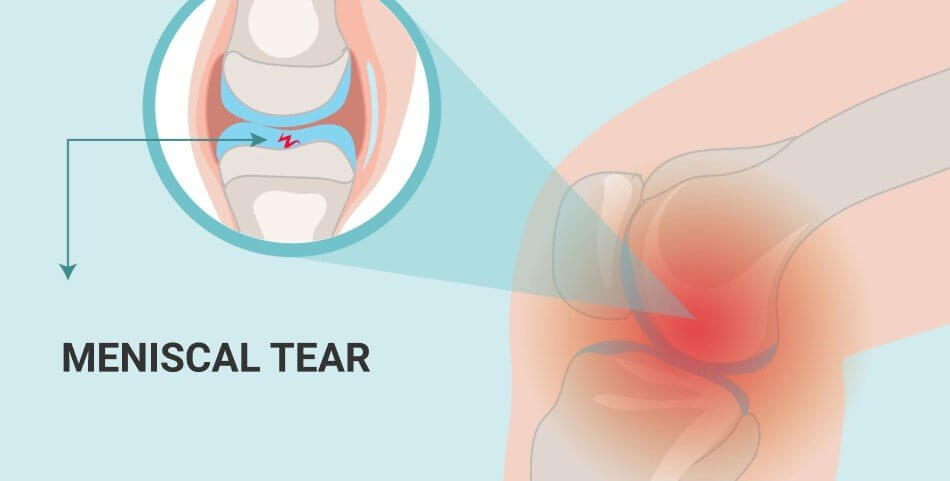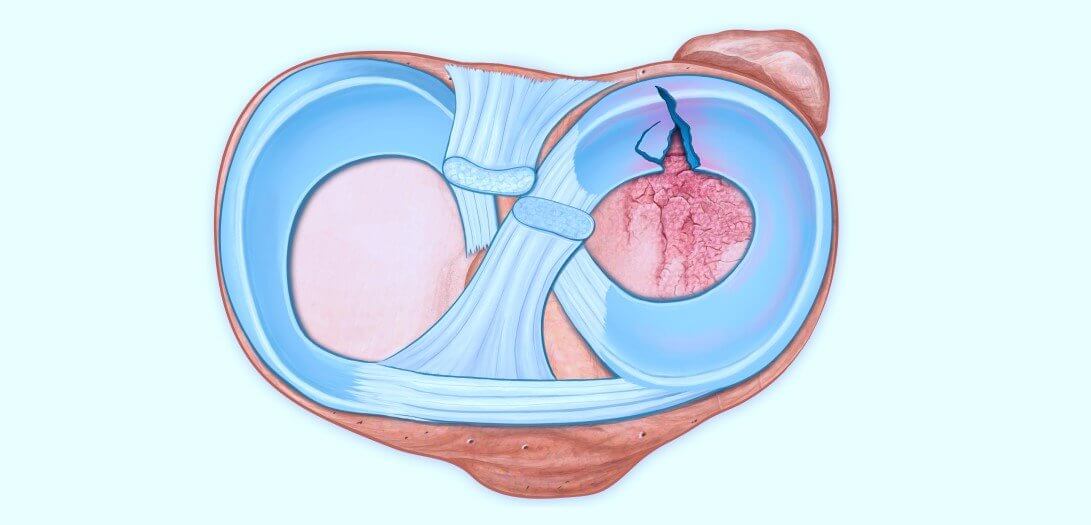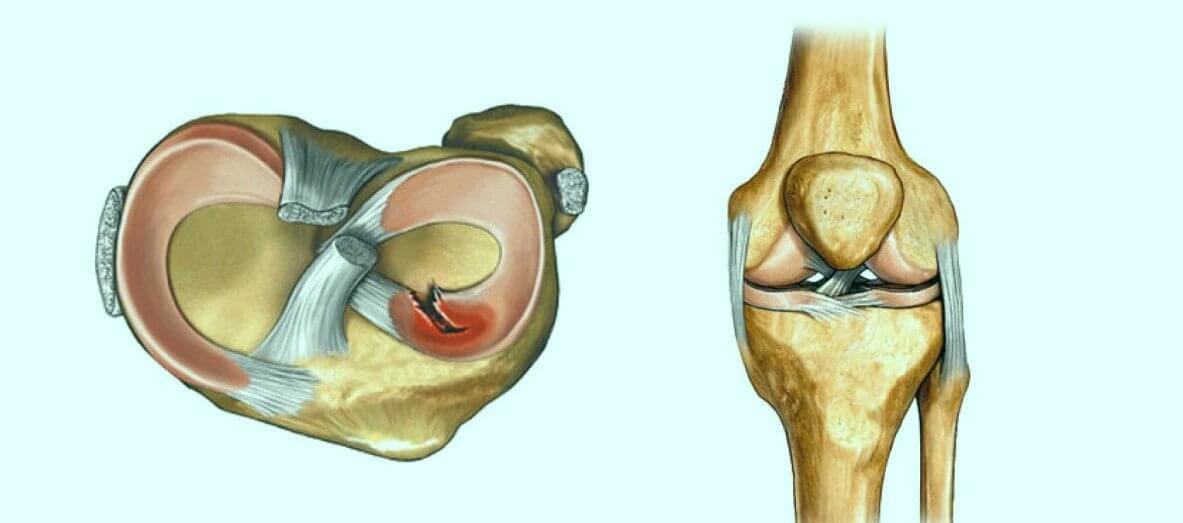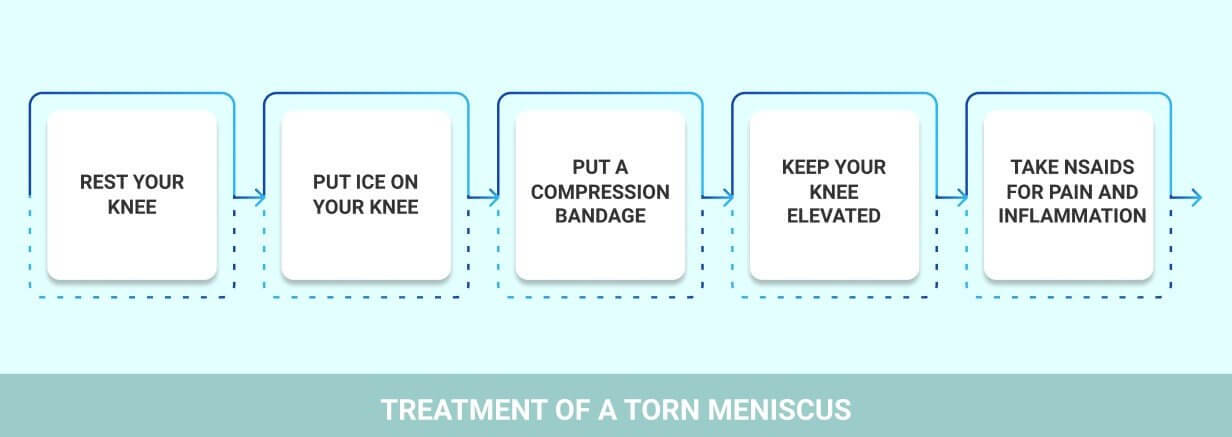Repairing a Tear in the Meniscus
A torn meniscus does not mean you will need surgery. Sometimes, the knee will lock, making it impossible to fully extend or bend the leg. This is more likely to require surgical intervention, as this type of meniscus tear is much more resistant to conservative care. Other types of meniscus tears respond well to physical therapy, with a 90 percent success rate.
Torn Meniscus – What It Looks Like
The knee has two large pieces of cartilage shaped like the letter C, located on top of the tibia bone. Their purpose is to protect the bones in the upper leg from hitting the bone in your lower leg.
Stress between the bones is absorbed by the meniscus when you are active, such as when walking, jumping, climbing or running. A meniscus is rubbery, but it can tear when rotating or twisting the knee with your foot in contact with the ground.
A tear of the meniscus is a rather common injury, particularly in people who play sports. About 40 percent of people over 65 also have them, and as many as half a million people suffer from them each year.
Torn Meniscus Symptoms
When you tear your meniscus, you may have a popping sound or sensation in your knee. Immediately afterward, you will feel pain on the inside or on outside of the knee. Swelling of the knee will be next, but it may take more than one day before it’s noticeable. People involved in sports may even be able to play for a couple of days afterwards. Once the swelling starts, the pain will likely be very noticeable, and it will be stiff at times.
One of the symptoms of a torn meniscus is the knee locking. It is also possible that your leg cannot be straightened, but it will hurt much more when the knee is twisted, or when squatting. There may also be a strong feeling that the knee is not going to support you, or that it is giving way.
In some situations with a meniscus tear, you will be able to carry on with most activities. If you use your knees in daily activities, you may be unable to continue to do them. Just going upstairs, or even walking, can cause serious pain. Participating in athletics is likely to cause the pain to start again, along with swelling.
In many cases, pain and swelling may subside in four to six weeks. However, if your knee cannot be straightened, you should see a doctor. You should also see a doctor if the knee locks and cannot be bent.
Causes Behind Tearing of the Meniscus
There are several activities that can cause a torn meniscus. The primary activity is sports, especially those where you make quick stops or sudden turns, as in basketball or football. There is an increase in the number of children with torn menisci because of the many children’s sports programs now available.
People who make sudden turns or deep squats, or who do heavy lifting are also subject to tears. After the age of 30, the meniscus usually begins to grow weaker and thinner, which is apt to be a common cause of tears in people of that age. At an older age, even simple movements may result in a tear, such as just getting up out of a chair.
Another torn meniscus cause is osteoarthritis. This common disease will weaken and further thin out the meniscus. If the joint did not already have osteoarthritis, it will likely develop if a piece of the meniscus moves around in the knee, causing more damage.
Diagnosing a Meniscus Tear
Once a tear of the meniscus is suspected, the doctor will first ask you what you were doing when it happened. The doctor will also likely move your knee and leg into different positions to help determine where the problem is and what might be causing it. Tenderness will also be watched for along the meniscus line.
It is also possible that an MRI might be needed, which will enable better viewing of the cartilage and describing specific damage. An x-ray or ultrasound will not reveal the whole span of the cartilage. However, since 90 percent of patients with meniscus tears respond to conservative care, diagnostic ultrasound combined with joint line tenderness becomes a diagnosis of exclusion, and the patient can proceed straight to physical therapy.
Progression of the Injury
Some people find that a meniscus with a small tear is not that bothersome. Others find it difficult to carry on with their normal activities. The difference may be the location and type of tear.
If the individual takes it easy, it is likely that the pain and swelling will decrease. This may allow for many normal activities to continue. Problems are apt to be seen when bending, or when going up or down stairs.
Self-Healing of the Damaged Meniscus
The meniscus has a blood supply that extends to about one-third of the outermost edges. This can enable faster healing where the blood supply is most abundant. In the past, the inner part of the meniscus was thought to be incapable of self-healing, but this has proven false in more recent research. When a meniscus is repaired with sutures, even where there is a low blood supply, it will heal.
In the past, many doctors believed that part of the meniscus would not heal, and they simply cut away the torn part of the meniscus. Unfortunately, this means an increased likelihood of getting osteoarthritis in that joint.
How to Treat Torn Meniscus Without Surgery
It is possible to treat very small tears in the meniscus yourself, as they simply heal on their own with time. Treatment of torn meniscus involves several steps, but it will help provide some relief to your painful and swollen knee.
Rest Your Knee – Stay off of your knee as much as possible. You should not use it for any activity other than just walking. You will also probably find it helpful to use crutches to avoid putting much weight on it.
Put Ice on Your Knee – Ice will enable you to reduce any swelling, but do not keep ice on it for more than 20 minutes at a time. Use ice one time about every two to three hours, for a couple of days.
Put a Compression Bandage on Your Knee – Swelling can also be limited by using a compression type bandage. Keep Your Knee Elevated – When not walking, it will help to keep your knee elevated with a pillow.
Take NSAIDs for Pain and Inflammation – Some over-the-counter medications will help to reduce the inflammation. These include medicines such as Motrin and Aleve. Use sparingly.
After the swelling has gone down, you may start a quadriceps strengthening program in your gym.
This should be composed of:
- Knee extensions
- Squats
- Hamstring curls
progressed to: - Single leg squats
- Lunges
- Lunges with twists
Make sure to use a range of movement that is pain free, and that exercises do not hurt afterwards. Use three sets of ten reps, progressing to fifteen. Progress your weight gradually.
If this still fails, you may want to consult your chiropractor for an individualized guided session.





























































